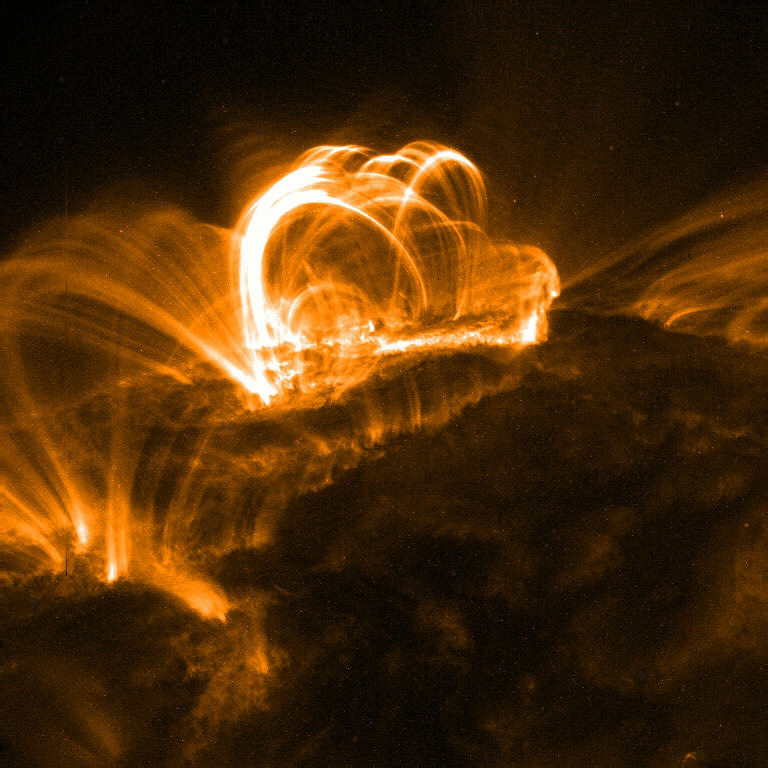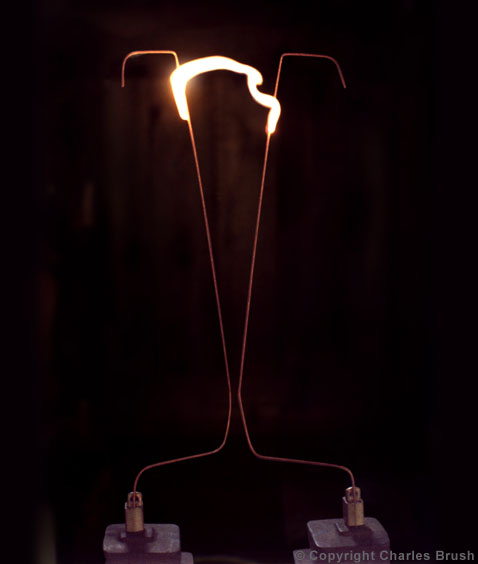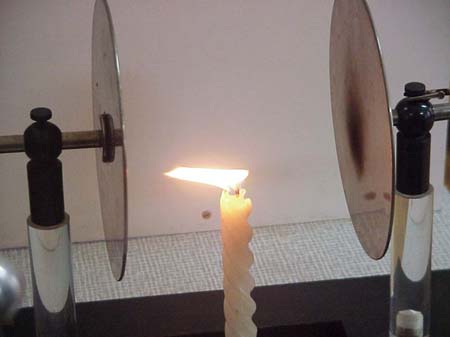Physicist: Generally speaking, by the time a gas is hot enough to be seen, it’s a plasma.
The big difference between regular gas and plasma is that in a plasma a fair fraction of the atoms are ionized. That is, the gas is so hot, and the atoms are slamming around so hard, that some of the electrons are given enough energy to (temporarily) escape their host atoms. The most important effect of this is that a plasma gains some electrical properties that a non-ionized gas doesn’t have; it becomes conductive and it responds to electrical and magnetic fields. In fact, this is a great test for whether or not something is a plasma.
For example, our Sun (or any star) is a miasma of incandescent plasma. One way to see this is to notice that the solar flares that leap from its surface are directed along the Sun’s (generally twisted up and spotty) magnetic fields.

A solar flare as seen in the x-ray spectrum. The material of the flare, being a plasma, is affected and directed by the Sun’s magnetic field. Normally this brings it back into the surface (which is for the best).
We also see the conductance of plasma in “toys” like a Jacob’s Ladder. Spark gaps have the weird property that the higher the current, the more ionized the air in the gap, and the lower the resistance (more plasma = more conductive). There are even scary machines built using this principle. Basically, in order for a material to be conductive there need to be charges in it that are free to move around. In metals those charges are shared by atoms; electrons can move from one atom to the next. But in a plasma the material itself is free charges. Conductive almost by definition.

A Jacob’s Ladder. The electricity has an easier time flowing through the long thread of highly-conductive plasma than it does flowing through the tiny gap of poorly-conducting air.
As it happens, fire passes all these tests with flying colors. Fire is a genuine plasma. Maybe not the best plasma, or the most ionized plasma, but it does alright.

The free charges inside of the flame are pushed and pulled by the electric field between these plates, and as those charged particles move they drag the rest of the flame with them.
Even small and relatively cool fires, like candle flames, respond strongly to electric fields and are even pretty conductive. There’s a beautiful video here that demonstrates this a lot better than this post does.
The candle picture is from here, and the Jacob’s ladder picture is from here.







Great item and amazing video. Would it be possible to use this phenomena to control fire or extinguish flames if you could get enough voltage to the fire? I’m thinking way off in the future here, but could fire-fighters turn up in a truck with a massive generator on board? or buildings be constructed with some sort of electrical defence system?
Another way to see this is candles in a microwave: http://www.youtube.com/watch?v=r6PPq8GwZgU Don’t try this at home!
This link seems to be a good explanation of plasma.
https://en.wikipedia.org/wiki/Plasma_(physics)
Amazing info, did not previously know fire was conductive and as such, influence upon it can be carried out by two electrodes between which a pre-established electrical field existed!
I knew that plasma was ionized gas, but I didn’t think it had those electromagnetic properties. The way you explained it though makes it seem obvious in hindsight. Nice post.
Nice to see another TMBG fan around here! This was certainly an interesting read as well!
If fire is more conductive than air, does that mean a tree on fire would be more likely to be hit by lightning than one not on fire?
I’ll just bet it is!
Just a question. How is it we seem to know so much about the universe in detail, yet so little about our weather systems here on earth? Or is there so much more to a microcasm than a macrocasm?
We know a tremendous amount about both! But if you’re wondering why we can’t predict the weather far in advance, it’s because weather is a “chaotic system“. One aspect of a system being chaotic is that you can understand everything about that system, and yet not be able to make accurate predictions.
Thank you very much for this post! I asked my chemistry teacher about this earlier… the funny thing is he said know one really knows what fire is. He said it isn’t a plasma, but that it’s a strange phenomenon that no one can really explain. I guess I’ll point him to this blog you write!
ohhhhhhhhhhhhhhh
Wait so is fire a plasma? Or a gas? (sorry they didnt really say; i may be the awesomest person on earth, but not the smartest person on earth 🙂 go ahead, laugh out loud {lol})
Thanks so much for this fascinating post. It’s made my home education task of responding to my son’s question much easier!
Some years ago myself and a friend of mine were walking home. It was a clear night and just after midnight. On the opposite side of the road we were on we saw what looked exactly like a “lightning ball” (or “plasma lamp”) the kind you can purchase. only what we saw was about 12-15 ft in diameter. It was very well defined and we could see it very clearly. We were on the sidewalk and it was just on the other side of the road. It looked exactly like those lamps I mentioned above. It was floating only about a foot off the ground and was not moving (save for the inside of it which was rotating and the “arms” which were acting just as those plasma lamps you can buy at toy stores and other places) the colors were just the same as those said lamps (Bright neon pinkish purple and electric blue). I am wondering if there is any info on such things happening in nature and what the cause would be? There was no sound coming from it and no power lines near to it. For some reason that still bugs me years later, we did not stop to watch it or even really give it any attention. It wasnt untill the next morning when we woke that we questioned what we saw. We then walked back to where we had seen it to investigate but could not find any evidence of it except for a small round patch of ground that was bare of grass approx where we thought we had witnessed it. (the area is a golf course and has very well kept grass.) ..the bare spot was not caused by a golfers club as it was perfectly round, flat and almost smooth. this has bugged me for over ten years now
Pingback: Materi asal penciptaan Jin | The Signs
You said that “The big difference between regular gas and plasma is that in a plasma a fair fraction of the atoms are ionized”
But in the video it shows that smoke is also composed of ionized atoms. Does this mean it is plasma too?
Excellent post,,we thanx u for this post and appreciate your work,,
Excellent post,,we thnx u for this post and appreciate your work,,
Pingback: Plasma in a Magnetic Field – Angelika J. Trojnarski
Pingback: Stars | mycosmicadventures
Pingback: «Fuego frío»: El fuego que congela cosas (vídeos) - NeoTeo
Pingback: Five Lies You’ve Been Told About the Sun